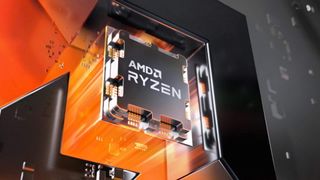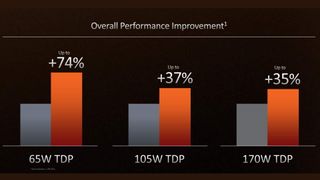Breaking down AMD's claims for a 13% Zen 4 IPC increase
Where does that 13% speed bump come from, and will it make all our games look awesome?

AMD has announced its new Ryzen 7000-series processors today, along with the news that the architecture is actually performing better than it initially expected. Back at the Computex reveal earlier in the year Zen 4 was given an 8 - 10% instructions per clock (IPC) increase over its Zen 3 progenitors, but now we're told that's gone up to around a 13% IPC gain.
With Zen 4 it became important for us to work on how we feed the instructions even faster into the machine.
Mark Papermaster, AMD
It is worth breaking that down, however. Both to get an idea of where that extra performance has come from, and how it actually breaks down in terms of how the architecture performs under different circumstances... because it's not just a straight 13% higher across the board. There are some pretty significant variances.
For starters, the geomean figures are derived from a performance testing suite of 22 different workloads, all run at a standardised 4GHz, and with the eight-core Zen 3 and Zen 4 processors.
That allows us to see straight architectural benefits, taking the increased clock speed of Zen 4 entirely out of the equation, on essentially like-for-like chips.
Mark Papermaster breaks down the performance increase at today's event, explaining that: "Zen 4 is a derivative of Zen 3. So we targeted, of course, enhancing on that base of Zen 3, building on the success.
"With Zen 3 we increased the execution width and so with Zen 4 it became important for us to work on how we feed the instructions even faster into the machine. And that's why you see most of the improvements coming from the front end and branch prediction. Really that makes up almost 60% of that IPC gain."


AMD has also increased the amount of cache on the chip, though not to the same extent as it has with the 3D V-cache on the Ryzen 7 5800X3D. That has an increased last level cache, but with Zen 4 AMD has doubled the L2 cache instead.
The biggest gaming news, reviews and hardware deals
Keep up to date with the most important stories and the best deals, as picked by the PC Gamer team.
That's been done "to provide critical data faster," says Mark Papermaster, "leading to that overall 13% IPC."
It's worth digging into those 22 different workloads, however. Because you'll see some games actually showing a far greater than 13% improvement, but also some, such as GTA V and Fortnite, showing far lower single figure increases.
It's also worth looking at the single threaded Cinebench R23 and CPU-Z figures, which show a 9% and 1% increase respectively. When AMD wants to talk separately about a single thread performance gain of 29% it uses the full 5.7GHz Ryzen 9 7950X running Geekbench to highlight that.


There is also the 5nm production process to think about here, too. When discussing the performance and efficiency benefits of using TSMC's 5nm production process for the computational dies of Zen 4, Papermaster explains the most significant performance gains appear at the lower-end of the power consumption curve.
When a 7950X is running at its 170W TDP it's showing up to 35% higher performance in the Cinebench R23 multi-threaded test compared with a 5950X. That rises to 37% at 105W, and to an astounding 74% at 65W.

That could highlight what a beast the lower TDP cores might end up being, particularly in laptop configurations. But it also potentially suggests the 13% IPC gains, performed as they were on an 8-core Zen 4 core running at 4GHz, aren't necessarily going to match in the real world when it's drawing a lot more power with something like the 170W 7900X or 7950X.
In the end the numbers AMD has provided are still worth interrogating because they provide a tantalising glimpse into what the new architecture can offer. And, when a Zen 4 core is pushed to a higher power draw it will be running at a significantly higher clock speed, which will also deliver more performance.
So there may yet be some fascinating benchmark results once we get chips in hand later next month.

Dave has been gaming since the days of Zaxxon and Lady Bug on the Colecovision, and code books for the Commodore Vic 20 (Death Race 2000!). He built his first gaming PC at the tender age of 16, and finally finished bug-fixing the Cyrix-based system around a year later. When he dropped it out of the window. He first started writing for Official PlayStation Magazine and Xbox World many decades ago, then moved onto PC Format full-time, then PC Gamer, TechRadar, and T3 among others. Now he's back, writing about the nightmarish graphics card market, CPUs with more cores than sense, gaming laptops hotter than the sun, and SSDs more capacious than a Cybertruck.
Most Popular

